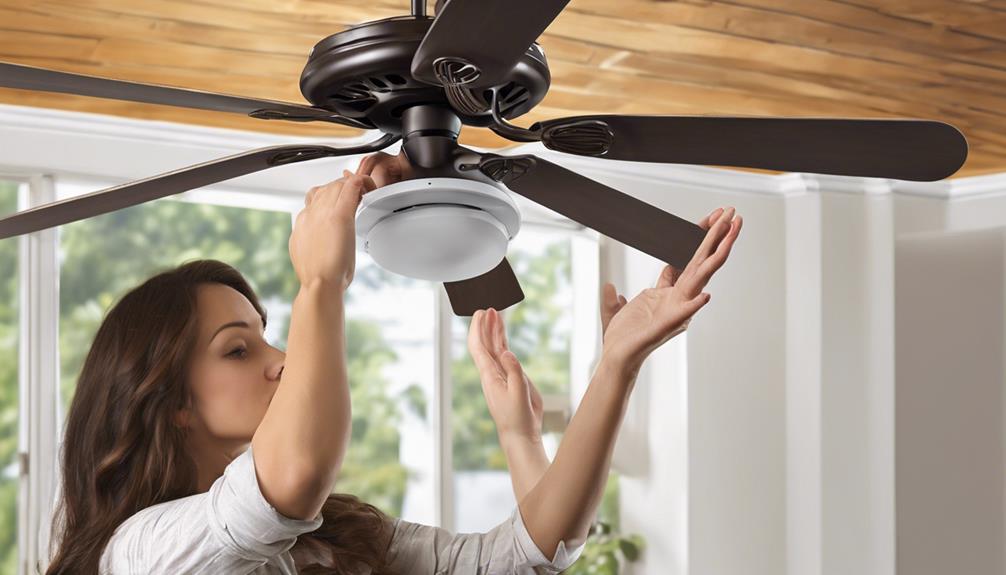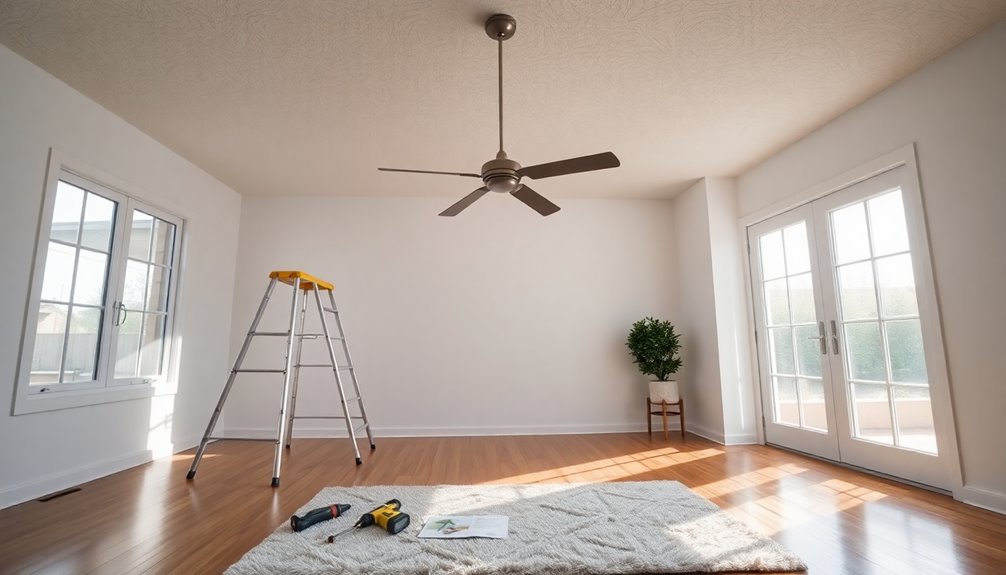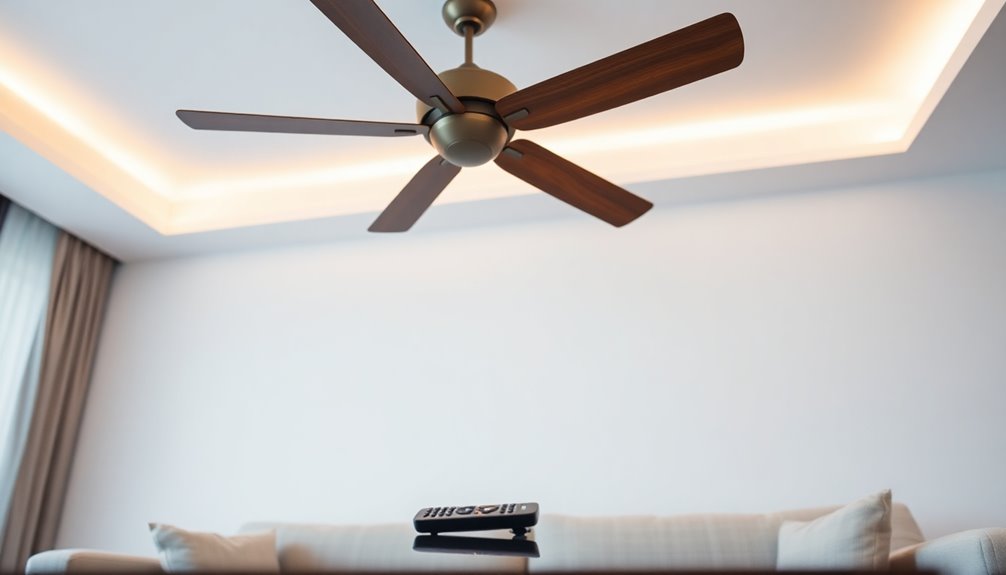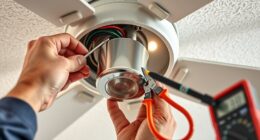If you're fed up with the constant hum of your ceiling fan, my firsthand advice to silence the noise includes inspecting for loose screws, tightening them to reduce humming, and ensuring proper mounting by using rubber spacers to minimize vibrations. Additionally, cleaning the fan blades regularly to remove dust and dirt, lubricating the motor for optimal performance, and securing all components can significantly reduce the noise level. Seeking professional help may also pinpoint the root cause and provide tailored solutions for effective noise reduction. Following these maintenance steps can swiftly restore peace and quiet to your living space.
Key Takeaways
- Tighten loose screws and components to reduce humming noise.
- Clean fan blades regularly to prevent dust buildup and humming.
- Ensure proper mounting using rubber spacers to minimize vibrations.
- Seek professional help for thorough inspection and tailored solutions.
- Address motor and wiring issues for optimal fan performance and quieter operation.
Identifying the Root Cause
When troubleshooting a humming ceiling fan, I begin by identifying the root cause through thorough inspection.
One common culprit for ceiling fan hums are loose screws. These can create vibrations that result in the annoying humming sound you hear. By checking the screws that hold the fan blades, motor housing, and even the light fixture securely in place, you can eliminate this source of noise.
Ensuring all screws are tightened properly can make a significant difference in reducing the hum of your ceiling fan. This simple step is often overlooked but can easily resolve the issue without the need for more complex repairs.
Taking the time to inspect and tighten any loose screws on your ceiling fan can lead to a quieter and more enjoyable fan experience. So, the next time your ceiling fan starts humming, remember to check those screws first before diving into more complicated troubleshooting steps.
Tightening Loose Screws

To reduce the humming noise coming from your ceiling fan, the first step is to tighten any loose screws on the fan components. Loose screws can lead to vibrations, causing that annoying ceiling fan noise. By using a screwdriver to secure all visible screws and bolts on the blades, motor housing, and mounting brackets, you can eliminate the source of the humming. Don't forget to check the junction box and electrical connections for any loose screws contributing to the noise. Properly securing all screws is crucial for minimizing the ceiling fan noise and ensuring smooth operation.
| Tightening Loose Screws | |
|---|---|
| Step 1 | Tighten blade screws |
| Step 2 | Secure motor housing |
| Step 3 | Fasten mounting brackets |
| Step 4 | Check junction box |
Cleaning the Fan Blades
When dealing with a humming ceiling fan, it's crucial to start by cleaning the blades.
Dust and dirt buildup can lead to unwanted noise.
Using a damp cloth or a mild detergent solution can effectively remove grime and maintain optimal fan performance.
Dusting Fan Blades
Regularly dusting fan blades is a simple yet effective way to prevent the accumulation of dirt and debris that can lead to fan noise. To keep your fan blades clean, use a microfiber cloth or a duster to gently wipe down both sides of each blade. This helps improve airflow efficiency and reduces the risk of the fan producing humming or buzzing sounds. By removing dust and grime from the blades, you can also maintain the balance of the fan for quieter operation. Remember, regular dusting of fan blades is a straightforward maintenance task that contributes to a quieter and more effective ceiling fan.
| Dusting Fan Blades Tips |
|---|
| Use a microfiber cloth |
| Gently wipe both sides |
| Maintain balance |
| Contributes to quietness |
Wiping With Damp Cloth
Keeping the fan blades clean by wiping them with a damp cloth is an effective way to remove dust and dirt that can cause unwanted noise. Regularly cleaning the ceiling fan blades prevents dust buildup, reducing the chances of humming.
To clean the blades, use a gentle cleaner or mild soap with water for better results. Remember to wipe the blades carefully to avoid bending or damaging them during the cleaning process.
This simple maintenance not only helps in silencing the fan hum but also contributes to maintaining air quality and improving the overall performance of your ceiling fan.
Using Blade Cleaner
To effectively clean your ceiling fan blades, consider using a blade cleaner to remove dust and dirt buildup efficiently. Using a blade cleaner ensures that debris is effectively removed, improving airflow and reducing noise from your ceiling fan.
Regularly cleaning the blades prevents excess noise and helps maintain the fan's efficiency. It's essential to use a gentle cleaner to avoid causing damage to the fan blades.
Remember to clean both sides of the blades thoroughly to ensure that all dirt and grime are removed. By incorporating a blade cleaner into your cleaning routine, you can keep your ceiling fan running smoothly and quietly, creating a more comfortable environment in your home.
Ensuring Proper Mounting

Using rubber spacers between the mounting bracket and the ceiling is crucial for reducing vibrations and noise in ceiling fans. These spacers act as a buffer, absorbing the vibrations that can cause the fan to hum. Additionally, adding rubber washers between the mounting bracket and the motor flange can provide even better sound insulation, further reducing any unwanted noise. Ensuring that all components are securely attached and in good condition is essential for a quiet ceiling fan.
Proper mounting also involves replacing worn-out rubber flywheels to maintain the connection between the blade brackets and the motor. Running new or unused fans for 12 to 24 hours can help reduce humming noise during operation as well. It's also important to check the electrical switch connected to the fan for any faults and replace it if necessary to prevent humming sounds. By paying attention to the mounting of your ceiling fan and making these adjustments, you can enjoy a quieter and more peaceful environment in your home.
Regular Cleaning and Lubrication

Regularly cleaning and lubricating your ceiling fan is essential for maintaining optimal performance and minimizing noise disruptions. Keeping your ceiling fan well-maintained not only ensures a quieter operation but also prolongs its lifespan.
Here are some simple steps to follow for regular cleaning and lubrication:
- Dust Off Dusty Blades: Wipe down the fan blades with a damp cloth to remove dust and dirt that can cause noise during operation.
- Silent Bearings: Apply a non-detergent oil to the fan motor bearings to reduce friction and eliminate humming sounds.
- Scheduled TLC: Set a maintenance schedule based on your fan's usage and the environment it's in to keep it running smoothly.
- Peaceful Operation: By regularly cleaning and lubricating your ceiling fan, you'll enjoy a quieter and more efficient fan that adds comfort to your space.
Seeking Professional Inspection

When facing persistent ceiling fan hum, the expertise of a professional electrician can be invaluable. Their evaluation can pinpoint the root cause of the noise, leading to tailored solutions.
Seeking qualified technician help ensures a safe and effective resolution to the issue.
Expert Evaluation
How can professional inspections help in identifying and resolving the root cause of ceiling fan humming?
Seeking a professional electrician's expert evaluation is crucial for pinpointing the source of the noise and implementing effective solutions. Here are some reasons why expert evaluation is beneficial:
- Certified electricians have the knowledge and tools to assess wiring, motor, and components accurately.
- Expert evaluation ensures a precise diagnosis, leading to specialized and tailored solutions.
- Professional inspections guarantee safety measures are adhered to during the resolution process.
- Seeking professional help provides peace of mind and ensures a long-term reduction in the annoying humming noise.
Qualified Technician Help
Engaging a qualified technician for a professional inspection is essential in pinpointing and resolving the root cause of the ceiling fan humming. By seeking expert help, you ensure that all electrical components are safe and functioning correctly, eliminating the annoying humming noise. These technicians possess the necessary knowledge and tools to accurately identify and address any issues contributing to the problem. Additionally, professional help can prevent further damage to your ceiling fan, guaranteeing long-term quiet operation. Trusting a qualified technician for a ceiling fan inspection provides peace of mind and a lasting solution to the humming noise issue.
| Benefits of Professional Inspection |
|---|
| Pinpoints root cause of humming |
| Ensures electrical safety |
| Prevents further damage |
| Long-term quiet operation |
Addressing Motor and Wiring Issues

To effectively address motor and wiring issues causing ceiling fan hum, start by tightening wire connections in the junction box to reduce humming caused by poor connections. Once you have checked the junction box, it's essential to lubricate the motor properly to prevent friction and humming noises.
Another crucial step is to inspect the motor housing for any faults and remove debris that may be causing rattling sounds. Additionally, ensure the compatibility of the fan control receiver to tackle buzzing or humming noises related to wiring effectively.
- Ensure all wire connections are tight for a smoother fan operation.
- Regularly lubricate the motor to maintain optimal performance.
- Keep the motor housing clean and free of debris to minimize unwanted sounds.
- Check the compatibility of the fan control receiver for a quieter fan experience.
Importance of Proper Installation

Proper installation plays a crucial role in minimizing ceiling fan hum. Ensuring secure attachment and following manufacturer guidelines can prevent vibrations and wobbling that lead to noise.
Opting for professional installation guarantees a quiet and stable fan operation.
Installation Impacts Noise
The effectiveness of reducing ceiling fan humming noise heavily relies on the correct installation procedures. When it comes to installation impacts on noise, here are some key points to consider:
- Proper installation reduces humming: Ensuring all components are securely attached during installation helps in noise reduction.
- Wobbling leads to noise: Incorrect installation can lead to wobbling, causing unnecessary noise.
- Balanced blades are key: Balanced and aligned fan blades from proper installation minimize humming.
- Follow manufacturer's instructions: Following manufacturer's instructions for installation is crucial for a quiet ceiling fan operation.
Professional Installation Ensures Quiet
Ensuring a quiet and efficient ceiling fan operation begins with entrusting the installation to a professional electrician who can expertly align components and eliminate potential sources of humming noise.
A professional installation ensures that the fan is securely mounted to prevent wobbling and vibrations, which are common causes of humming. These experts also check and tighten all electrical connections, addressing any issues that could lead to unwanted noise.
Proper motor housing alignment and balance are key factors in minimizing fan noise, tasks best handled by professionals. By opting for professional installation, you can rest assured that your ceiling fan is mounted correctly, reducing the likelihood of humming problems in the future.
Trusting the experts ensures a peaceful and quiet fan experience for years to come.
Immediate Noise Resolution

To swiftly address the irritating humming from your ceiling fan, begin by tightening wire connections in the junction box. This simple step can often resolve the issue of a noisy ceiling fan making an annoying humming sound.
Additionally, lubricating the motor properly can help decrease friction and reduce humming sounds. Check for any debris in the motor housing and remove it to prevent rattling noises that can add to the unwanted noise.
Ensure that all light bulbs are tightly secured as loose bulbs can also contribute to the humming. If these steps don't fully resolve the problem, it may be beneficial to contact a professional electrician for further assistance in fixing your noisy ceiling fan.
Preventive Maintenance Tips

Regularly maintaining your ceiling fan through cleaning and lubrication is essential in preventing unnecessary friction and humming noises. Dust and dirt can accumulate on the blades and motor over time, leading to increased friction and annoying hums. By cleaning these parts and applying lubricant as needed, you can ensure smooth operation and a quieter fan.
Additionally, check for loose screws and connections in the fan to fix any wobbling or rattling noises. Using rubber spacers or washers can help reduce vibrations and further minimize noise levels. Running the fan for 12-24 hours after lubrication allows the oil to spread evenly, reducing humming, especially at low speeds.
Don't forget to inspect and replace worn-out components like the flywheel to maintain a quiet ceiling fan. These preventive maintenance tips can help keep your fan running smoothly and quietly, enhancing your comfort and enjoyment.
Common Noise Prevention Methods

By placing rubber spacers between the mounting bracket and the ceiling, noise transmission from the ceiling fan can be effectively reduced. This simple step can make a significant difference in the overall noise level generated by the fan.
In addition to this method, there are other common noise prevention techniques to consider:
- Lighten the Load: Ensure that the fan blades aren't overloaded with dust or debris, as this can cause imbalance and unnecessary noise.
- Tighten Up: Check for any loose blades and tighten them to prevent unnecessary wobbling and noise during operation.
- Keep it Balanced: Regularly balance the fan blades to avoid vibrations that can lead to humming noises.
- Stay Secure: Make sure that all screws and components are securely fastened to prevent any rattling or shaking that could contribute to the noise level.
These steps can help create a more peaceful and serene environment, allowing you to enjoy the benefits of your ceiling fan without the unwanted noise disruptions.
Benefits of Quiet Ceiling Fans

Reducing noise transmission through effective methods like placing rubber spacers can lead to a more peaceful environment, highlighting the benefits of quiet ceiling fans. Quiet ceiling fans play a crucial role in enhancing indoor comfort by creating a tranquil atmosphere ideal for relaxation and sleep.
The reduced noise levels from these fans contribute to a quieter living space, promoting overall well-being and a sense of belonging. Their silent operation allows for undisturbed conversations, reading, or work without background noise interference, fostering a peaceful environment to connect with others.
Additionally, quieter ceiling fans aid in better concentration and focus by minimizing distractions in the room, making it easier to engage in tasks and activities. The peaceful surroundings created by silent ceiling fans can significantly improve the quality of sleep, ensuring restorative rest and a refreshed start to the day.
Frequently Asked Questions
How Do I Fix the Humming Noise in My Ceiling Fan?
To fix the humming noise in your ceiling fan, I recommend checking the fan balance and ensuring proper motor lubrication. These simple steps can often eliminate the annoying sound.
I suggest starting with these basic troubleshooting techniques before seeking professional help.
How Do I Silence a Noisy Ceiling Fan?
To silence a noisy ceiling fan, start by checking fan blade balance and lubricating the motor. Ensure the blades are aligned properly for quiet operation. Tighten any loose screws and clean out debris from the motor housing.
Regular maintenance like this can help prevent humming sounds and ensure a peaceful environment in your living space.
How Do I Get Rid of Fan Hum?
To get rid of fan hum, I focus on the motor and electrical interference. Did you know that a well-maintained fan motor can last up to 10 years?
Start by checking connections and tightening screws. Lubricate the motor and clear debris from the housing. Ensure light bulbs are secure.
Addressing these issues can eliminate that annoying hum and keep your fan running smoothly.
How Do I Eliminate the Buzzing Noise in a Ceiling Fan When It Runs on Inverter?
To eliminate the buzzing noise in a ceiling fan when it runs on an inverter, ensure inverter compatibility and consider soundproofing techniques. Check the ground connection and wiring for proper electrical flow. Consult an electrician for installing filters or noise suppressors. Shielded cables or ferrite beads can help minimize electromagnetic interference. Using power conditioners or surge protectors can also reduce inverter noise.
Prioritize safety and follow expert advice for a quiet fan experience.
Can Bladeless Ceiling Fans Help Reduce or Eliminate Ceiling Fan Humming?
Bladeless ceiling fans explained: Bladeless ceiling fans can help reduce or eliminate ceiling fan humming. The absence of traditional fan blades means that there is no noise from air moving through them. This makes bladeless ceiling fans a great option for those who are looking for a quieter and more peaceful environment.
Conclusion
In conclusion, addressing the hum of a ceiling fan can greatly improve the overall ambiance of a room.
Did you know that a properly maintained ceiling fan can save you up to 15% on cooling costs during the summer months?
By following the steps outlined in this article, you can enjoy a quieter and more efficient fan that enhances your comfort and energy savings.









